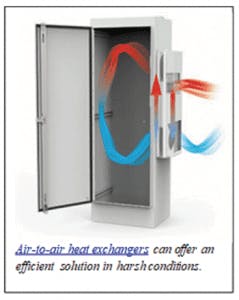Selecting the Optimal Thermal Management Technology
The use of cooling technology is ubiquitous across industry, yet choosing the correct technology for a specific application can prove a challenge. Each choice depends on a variety of factors and the wrong choice could lead to tremendous losses for a business.
As thermal management technology options proliferate, choosing the correct cooling product can ensure continuous operation at low cost by protecting critical electronic systems. An incorrect choice could be disastrous, resulting in decreased productivity and efficiency, increased maintenance frequency, and even compromised safety.
In order to avoid these costly mistakes, facilities engineers should evaluate both cooling requirements and ambient circumstances before selecting a technology. These include heat load, the ambient temperature range, the presence of particulates or debris, enclosure location and material, and various other specifications.
This brief guide equips engineers with a basic framework to determine the best thermal management option for an application.
InvisiLight® Solution for Deploying Fiber
April 2, 2022Go to Market Faster. Speed up Network Deployment
April 2, 2022Episode 10: Fiber Optic Closure Specs Explained…
April 1, 2022Food for Thought from Our 2022 ICT Visionaries
April 1, 2022Higher Enclosure Temperature Than Ambient Temperature
In the majority of applications, a standard filter fan matches requirements. As far as thermal management goes, these are the baseline product for most enclosure and electronics cooling. The original is the Filterfan™, invented by Pfannenberg as a flexible solution for many basic cooling needs. It is the perfect cooling technology for non-hazardous environments when ambient temperatures are cooler than the intended enclosure temperature. Filter fans simply utilize pressure differentials to displace warm air in an enclosure with cooler, ambient air from outside. These products are affordable, effective, and can be utilized in multiple contexts to meet specific business needs. Pfannenberg Filterfans 4.0™ are being adapted to meet endless applications, from factory control boxes to the unexpected. Even outdoor billboards now use this technology.
Higher Ambient Temperature Than Enclosure Temperature
Both filter fans and air-to-air heat exchangers are only viable, however, if the temperature inside the enclosure should be higher than in the ambient environment. Otherwise, alternate cooling technologies will offer a better solution.
The primary alternative is a closed loop cooling unit. These units actively pump out heat from the enclosure while simultaneously cooling the air with an evaporator. This process, when coupled with a dehumidifier, allows closed loop cooling units to operate without relying on a cooler ambient temperature. Like air-to-air exchangers, the enclosure is completely separated from the ambient air.
With extremely hot or dirty outside conditions, however, a closed loop cooling unit may not suffice. In these circumstances, chillers and air-to-water heat exchangers offer preferable methods of heat removal. A chiller is used for cooling needs that involve high or fluctuating heat-loads, precise temperature controls, or the need for flexibility in the location of the cooling unit. The food and beverage industry, for example, often utilizes these technologies to fit their specific cooling requirements. Chillers operate like basic refrigerators and can be modified based on coolant type, heat-load needs, or environment type. Alternatively, an air-to-water heat exchanger transfers heat into an on-site water source. This allows for cooling without any heat being transferred into the ambient environment. If a water source is not available on site, a cooling solution involving a system made of both chiller and air to water exchanger is often installed.
Thermal Management Expertise Can Save Costs
Although these are the basic rules of thumb for proper thermal management, considerations must be made for sizing and wattage requirements, along with any other factors that may result in an exception to these guidelines. Recall that a wrong choice in cooling technology can prove costly: productivity, energy efficiency, equipment longevity, maintenance, safety, and overall cost all could be affected.
With so much at stake, many businesses decide to consult with industry experts before making a decision on what technology is best for their needs. Many industry experts provide case-by-case cooling solutions and maintenance.
The right advice can result in a major improvement in operations. For one large plastics manufacturer, plastic dust in the air constantly coated the heat-exchanging coil inside the factory AC units, causing them to fail. We suggested an enclosed system to fix the problem in the form of a combined chiller and air-to-water exchanger, ultimately saving the manufacturer thousands of dollars in downtime and maintenance.
The selection process is complicated, and utilizing the expertise of application engineers is often the most efficient way to ensure the proper selection of a cooling system.
The need for proper cooling technology provides a first line of defense against the degradation of critical electronics, facilitating innovation in the new digital economy. To fully capitalize on the latest thermal management technologies, businesses must prudently consider all variables and conditions during the selection process.
Like this Article?
Subscribe to ISE magazine and start receiving your FREE monthly copy today!
About the Author: This article is written by Adam Wells, Pfannenberg. Pfannenberg, Inc. is a global manufacturer of thermal management, liquid cooling solutions and signaling technologies. Established in 1954 by Otto Pfannenberg, for over 60 years the Company has been recognized as an industry leader within the Electrotechnology Industry. For more information, please visit https://www.pfannenbergusa.com/thermal-management/cooling-units/.





